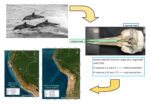Influence of interference competition and seasonality on the activity patterns of carnivorous mammals in the Brazilian Cerrado
Isadora Oliveira Machado, André de Almeida Cunha, José Luiz de Andrade Franco, Ludmilla M.S. AguiarThe pattern of activity of species can be influenced by environmental and biological factors and can change according to seasonality. In general, the activity pattern of species of the order Carnivora is influenced by air temperature and humidity, prey activity pattern, human presence, and competition. To answer whether there is temporal niche segregation between Cerrado carnivore species and whether the pattern of activity of Cerrado carnivores changes between the two well-marked seasons of the biome, we collected data on native carnivores with camera traps over a year. Species were active mainly in the twilight and night periods, with high overlap in their activity schedules. Activity patterns of the crab-eating fox and puma were significantly different, which indicates that the canid may be avoiding the competing species in time to avoid agonistic interactions. Furthermore, the peak activity periods of the four carnivore species do not overlap, suggesting that competition is a secondary mechanism determining the activity pattern of these species. The activity patterns of the species did not differ significantly between seasons. However, the crab-eating fox tended to be more diurnal in the rainy season, while the puma tended to be more diurnal in the dry season.
Influência da competição de interferência e da sazonalidade nos padrões de atividade de mamíferos carnívoros no cerrado brasileiro. O padrão de atividade das espécies pode ser influenciado por fatores ambientais e biológicos e mudar conforme a sazonalidade. Espécies da ordem Carnivora em geral têm o padrão de atividade influenciado pela temperatura e umidade do ar, pelo horário de atividade das presas, pela presença humana e pela competição. Para responder se há segregação de nicho temporal entre espécies de carnívoros do Cerrado e se o padrão de atividade dos carnívoros do Cerrado muda entre as duas bem-marcadas estações do bioma, coletamos dados de carnívoros nativos com armadilhas fotográficas ao longo de um ano. As espécies foram ativas principalmente nos períodos crepuscular e noturno, com alta sobreposição do horário de atividade. Os padrões de atividade do cachorro-do-mato e da suçuarana foram estatisticamente diferentes, o que indica que o canídeo pode estar evitando a espécie competidora no tempo para evitar interações agonísticas. Além disso, os horários de pico de atividade das quatro espécies de carnívoros não se sobrepõem, sugerindo que a competição é um mecanismo secundário na determinação do padrão de atividade dessas espécies. Os padrões de atividade das espécies não diferiram significativamente entre as estações, mas o cachorro-do-mato mostrou tendência a ser mais diurno na estação chuvosa, enquanto a suçuarana tendeu a ser mais diurna na estação seca.




